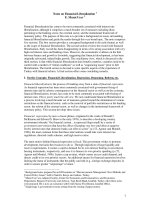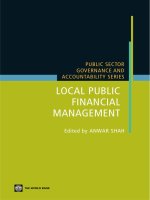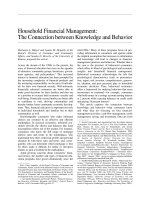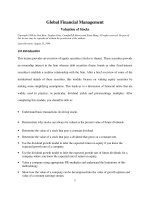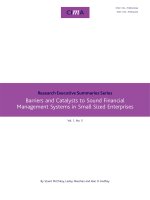focus on financial management
Bạn đang xem bản rút gọn của tài liệu. Xem và tải ngay bản đầy đủ của tài liệu tại đây (3.2 MB, 243 trang )
FOCU$ ON
FINANCIAL
MANAGEMENT
This page intentionally left blank
FOCU$
ON
FINANCIAL
MANAGEMENT
Ivan K. Cohen
Richmond, the American International
University in London
imperial College Press
Published by
Imperial College Press
57 Shelton Street
Covent Garden
London WC2H 9HE
Distributed by
World Scientific Publishing Co. Pte. Ltd.
5 Toh Tuck Link, Singapore 596224
USA office: 27 Warren Street, Suite 401-402, Hackensack, NJ 07601
UK office: 57 Shelton Street, Covent Garden, London WC2H 9HE
British Library Cataloguing-in-Publication Data
A catalogue record for this book is available from the British Library.
FOCUS ON FINANCIAL MANAGEMENT
Copyright © 2005 by Imperial College Press
All rights reserved. This book, or parts thereof, may not be reproduced in any form or by any means,
electronic or mechanical, including photocopying, recording or any information storage and retrieval
system now known or to be invented, without written permission from the Publisher.
For photocopying of material in this volume, please pay a copying fee through the Copyright
Clearance Center, Inc., 222 Rosewood Drive, Danvers, MA 01923, USA. In this case permission to
photocopy is not required from the publisher.
ISBN 1-86094-479-5
Printed in Singapore.
This book is dedicated to those who came before, and to those who
follow on.
Firstly, this book is dedicated to the memory of my late father, Issy
(Israel) Cohen z”l, and my beloved mother, Irene Cohen. Together they
brought me up to be a mensch, and their love and support has enabled me
to live a fulfilling life without giving up on fun.
Secondly, this book is dedicated to my two children, David Jonathan
(Yoni) and Maya Isabella, whose energy and vitality keep me going even
as they run me ragged! The link between the two groups is my incredible
and beautiful wife, Jeanine, whose love continues to be a constant source
of strength.
v
This page intentionally left blank
Preface
This book began its journey to fruition many years ago when I was a
Lecturer at the Management School at Imperial College. At that time I
was approached by Tony Moore and asked to contribute a textbook in
Finance to the Imperial College Press. Early progress was swift, but soon
slowed down due to the interference of “life’s rich tapestry” as appears to
often be the case. Having started the book as a single man with no major
attachments (notwithstanding a passion for Tottenham Hotspur F.C.!),
this book enters publication with the author a married man with two
young children.
In writing this book I have been led by my own comments on texts
from my student days, as well as by those of my own groups of students
on the many contemporary texts in this area. One consequence is that I
have tried to keep this book relatively short, to the point, and maintain a
good flowing narrative. Too often, undergraduate textbooks drown the
reader in a sea of numerous examples, so that the flow of the material
gets lost and it becomes difficult to “see the wood for the trees”. I have
deliberately opted for a short, focused text, rather than the more
encyclopædic variety that inhabits and weighs down too many student
bookshelves. I have also tried to maintain a sense of high quality,
readable English that treats the reader as an equal. I hope that I will be
regarded as successful in these areas. As always, any errors, both of
omission and commission, remain my own responsibility.
vii
This page intentionally left blank
Acknowledgements
This book would never have come to fruition had it not been for the
love and support of my wife, the “stupendously sexy” Jeanine. A debt of
thanks is also due to my young children, David Jonathan (“Yoni”) and
Maya Isabella, who must have wondered what it was their father was
doing at his G3 Macintosh computer on so many occasions. I am also
indebted to my stepson, Aviel Levy, for his support and encouragement.
I would also like to record my thanks to my three brothers, Steven,
Alan and Neil, as well as to their respective families, for their support,
often in the form of familial banter.
This project began at the prompting of Tony Moore, then of Imperial
College Press, and his help in getting the book started was invaluable.
Since then I have benefited from the valuable insights of the Imperial
College Press team.
A number of friends, colleagues and students were kind enough to
read drafts and offer comments. My thanks go out in particular to
Raymond Antian, Daniel Cohen (no relation), Catherine Dick, Sharon
Foley, Debby McLean, and Mihail Nedev, although the responsibility for
any errors remains squarely with me. At Imperial College Press, I am
indebted to Geetha Nair and Gabriella Frescura for trying to ensure I
made some kind of timely progress, as well as to Kim Tan for
substantive comments on draft versions of the text. More recently I owe
a huge debt of thanks to Katie Lydon for her editing prowess.
Finally, my thanks go out to the Spurs-List, an e-mail forum, which
brought me and my wife together, as well as enabling me to be blessed
with an abundance of great friends. I also would like to thank Tottenham
Hotspur F.C., whom I have followed through thick and thin (mostly
the latter in recent years!) as both man and boy. I hope this book finds
as receptive an audience as the teams of Billy Nicholson, Keith
Burkinshaw, and whomever is the manager when this book finally hits
the shelves.
ix
This page intentionally left blank
Contents
Preface.....................................................................................................vii
Acknowledgements ..................................................................................ix
1.
Introducing Finance .........................................................................1
1.1 The Stuff of Finance ..............................................................2
1.2 The Firm ................................................................................4
1.2.1 What is a firm? .........................................................4
1.2.2 The objective of the firm ..........................................5
1.1.2.1 Profit maximisation or wealth maximisation?..........6
1.3 Corporate Structure ...............................................................7
1.3.1 Sole proprietorship ...................................................7
1.3.2 Partnership................................................................8
1.3.3 Limited companies ...................................................9
1.4 The Finance Function ..........................................................12
1.5 Principals and Agents ..........................................................13
1.5.1 Maximising versus satisficing ................................15
1.5.2 Management goals..................................................16
1.5.3 Shareholders’ goals ................................................17
1.5.4 Bondholders’ goals.................................................17
1.5.5 Other stakeholders’ goals .......................................18
1.5.6 In summary.............................................................19
1.6 Finance versus Accounting..................................................20
2.
The Financial Environment............................................................23
2.1 Macroeconomics and Finance .............................................23
2.2 The Financial System: Markets and Institutions .................24
2.2.1 Types of financial market .......................................26
2.2.2 Efficient markets ....................................................29
2.3 Investment and Finance.......................................................31
2.4 Accounting for Finance .......................................................32
2.4.1 The balance sheet ...................................................33
xi
xii
Focus on Financial Management
2.5
2.4.2 The income statement.............................................34
2.4.3 The cash flow statement .........................................35
Taxation and Inflation .........................................................37
2.5.1 Personal taxation ....................................................37
2.5.2 Capital gains tax .....................................................39
2.5.3 Corporation tax.......................................................39
2.5.5 Inflation ..................................................................40
Appendix: Sources of Financial Information ..........................................43
Traditional “print” media...............................................................43
Online and broadcast media...........................................................44
America Online, the Motley Fool and more ..................................44
3.
Value: Finance Foundations ..........................................................47
3.1 What Is Value? ....................................................................47
3.2 The Time Value of Money I: Simple Interest......................48
3.3 Simple Interest: Applications ..............................................50
3.3.1 Term loans ..............................................................50
3.3.2 Discount claims ......................................................51
3.3.3 Yield-quoted instruments .......................................52
3.4 The Time Value of Money II: Compound Interest..............54
3.4.1 The mechanics of compound interest .....................54
3.4.2 Comparing simple and compound interest .............56
3.4.3 Annuities ................................................................57
3.5 Net Present Value and Internal Rate of Return ...................59
3.5.1 Net Present Value ...................................................59
3.5.2 “Special” cashflow streams ....................................62
3.5.3 The Internal Rate of Return (IRR)..........................66
4.
Sources of Finance: Debt ...............................................................71
4.1 What is debt? .......................................................................71
4.2 Debt valuation .....................................................................75
4.3 Not-quite-debt: hybrids .......................................................77
4.4 Interest rate determination...................................................78
4.5 The Term Structure of Interest Rates ..................................81
4.5.1 The Expectations Hypothesis .................................82
4.5.2 Liquidity Preference ...............................................84
4.5.3 Hedging pressure/Preferred habitat/Market
segmentation...........................................................85
4.5.4 Clientele effect........................................................87
Contents
4.5.5
xiii
Afterthoughts..........................................................87
Appendix: Notes on Debt Sources ..........................................................89
Short- and Medium-Term Debt......................................................89
Long-Term Debt ............................................................................92
5.
Sources of Finance: Equity ............................................................93
5.1 What Is Equity? ...................................................................93
5.1.1 Types of share capital.............................................93
5.2 Ordinary Shares (or Stock) ..................................................94
5.3 Preference Shares ................................................................95
5.4 Other Points of Note............................................................96
5.5 Raising Equity Capital.........................................................97
5.6 Equity Valuation................................................................101
5.6.1 Share price valuation I: The basic model .............102
5.6.2 Share price valuation II: The Gordon growth
model....................................................................104
5.7 Dividends...........................................................................107
5.8 Not-quite-equity: Options..................................................109
6.
Investment Appraisal: Capital Budgeting ....................................115
6.1 Investment Projects ...........................................................116
6.2 Cashflows ..........................................................................118
6.3 Investment Appraisal: Basic (Non-DCF) Methods ...........120
6.3.1 The payback period ..............................................121
6.3.2 The finite horizon criterion...................................123
6.3.3 Accounting Rate of Return...................................123
6.3.4 Profitability index.................................................124
6.4 Investment Appraisal: Discounted CashFlow (DCF)
techniques ..........................................................................124
6.4.1 Net Present Value .................................................124
6.4.2 Internal Rate of Return (IRR)...............................128
6.4.3 Capital rationing ...................................................132
6.5 Comparison of NPV with IRR...........................................133
6.5.1 Number of solutions .............................................133
6.5.2 Scale and duration ................................................136
6.6 In Summary: Some General Guidelines for Capital
Budgeting ..........................................................................138
6.7 Real and nominal values....................................................139
6.8 Sensitivity and Scenario Analysis .....................................142
xiv
Focus on Financial Management
6.9
6.8.1 Sensitivity analysis ...............................................142
6.8.2 Scenario analysis ..................................................143
Newer Approaches to Capital Budgeting ..........................144
7.
Investment Appraisal: Risk..........................................................145
7.1 Risk and Return .................................................................146
7.1.1 Yield (or expected return) ....................................146
7.1.2 Risk and uncertainty .............................................149
7.1.2 Risk and probability .............................................150
7.2 Portfolio theory: The Markowitz Approach ......................153
7.2.1 Portfolio returns....................................................154
7.2.2 Portfolio risk.........................................................155
7.3 Market Risk .......................................................................162
7.3.1
The beta coefficient (β ).......................................163
7.4 The Capital Asset Pricing Model (CAPM)........................166
7.4.1 Value additivity ....................................................171
7.5 Arbitrage Pricing Theory...................................................172
8.
The Cost of Capital ......................................................................175
8.1 Overview ...........................................................................175
8.2 Sources of Capital..............................................................175
8.3 The Cost of Debt ...............................................................176
8.4 The Cost of Equity.............................................................177
8.5 Other Costs of Capital .......................................................179
8.5.1 The cost of retained earnings................................179
8.5.2 The cost of preference shares ...............................180
8.6 The Total Cost of Capital ..................................................181
9.
The Capital Structure Conundrum ...............................................185
9.1 Value maximisation...........................................................185
9.2 The “Traditional” View.....................................................186
9.3 Modigliani and Miller (1958) ............................................188
9.3.1 Criticisms of Modigliani and Miller.....................191
9.3.2 MM Modifications................................................191
9.4 A Final Thought ................................................................194
10.
Extending the Focus: Some Applications ....................................195
10.1 Valuation of the Firm ........................................................195
10.1.1 Free cash flows ...................................................196
10.1.2 EVA and MVA...................................................196
Contents
xv
10.2 Corporate Restructuring: Mergers and Acquisitions .........197
10.2.1 Leveraged buyouts (LBOs) ................................200
10.2.2 Mergers and macroeconomics ............................200
10.2.3 Merger evaluation...............................................201
10.3 Pensions.............................................................................203
10.3.1 FRS 17 ................................................................204
10.4 Finance in the International Arena ....................................205
10.4.1 Foreign exchange (forex or fx) ...........................206
10.4.2 International capital budgeting ...........................215
10.5 The Limitations of Finance ...............................................217
Bibliography..........................................................................................219
Index .....................................................................................................223
This page intentionally left blank
1.
Introducing Finance
The main objective of this book is to introduce and familiarise the reader
with the financial management of the business enterprise. This involves
learning the language of finance, the environment in which finance
takes place, as well as a number of methods of financial analysis.
Additionally, a number of finance theories are discussed on the basis that
understanding them will enhance the ability to make financial decisions.
Some of the theories have yet to find a consensus among financial
economists, and thus there are several views that need to be considered.
While my aim is to make the subject matter “user friendly”, there is a
certain amount of technical material that cannot be avoided. Nonetheless,
mathematical material has been kept to a discreet minimum, and even
those with “mathematics-phobia” should be able to glean much more
than the gist of the argument!
For many people the words finance and money are equivalent.
However, such thinking can obscure the real insights that finance has to
offer. While money is an object that enhances trade, finance is a field
involved with decision-making concerning the use of money and credit;
it is simultaneously an art and a science. Like all economic decisionmaking, finance involves a weighing-up of benefits against costs, and is
therefore very much a sub-field of economics. Cost in economics refers
to the concept of opportunity cost: “the cost of the next best alternative
foregone”. Thus, cost does not simply mean what has been paid for a
given commodity, but rather what else might have been purchased
instead. While in many cases both benefits and costs can be measured in
monetary terms, this is not always possible, and there is increasing effort
being made by finance experts to find methods to estimate or “proxy”
non-monetary valuations. Costs and benefits for which no market
valuation is available are often referred to as externalities. Their
measurement or valuation is especially important for investments being
1
2
Focus on Financial Management
undertaken by the public sector or those which are likely to have a
significant social or environmental impact (which might be positive or
negative).
It is important to think of finance as an economic phenomenon that
occurs in time. For any economic agent—such as an individual, a
business, or government—the timing of inflows of funds and outflows of
funds will not automatically balance. Almost everyone who has been a
student has had to experience the problem of bills needing to be paid
when the grant (or loan) for the current period has run out. Finance might
be thought of as the art of bringing fund inflows and outflows into some
kind of balance. On these grounds finance may best be considered
visually, occurring along a time-line:
££££ outflow
time
££££ inflow
££££ inflow
Visualisation of the flows of funds can also be made by proper use of a
computer spreadsheet:
Time period
0
1
Cash outflows
(£10,000)
(£1,000)
Net cash flow
(£10,000)
(£1,000)
Cash inflows
1.1
2
3
4
£3,000
£5,000
£6,000
(£500)
£2,500
(£500)
£4,500
(£500)
£5,500
The Stuff of Finance
Ultimately, finance is about making decisions. Personal finance deals
with making individual and family financial decisions: where to save,
what type of insurance or pension scheme meets a person’s requirements,
and so on. This book focuses on corporate finance, which deals with
financial decision-making within the context of the firm. The same
principles we discuss apply equally to the not-for-profit firm. Other areas
of finance might include investment management, or financial markets
and institutions.
1. Introducing Finance
3
Although there may be an element of the abstract, financial theory
aims to provide financial decision-makers with better tools. Better tools
make for better decisions. Equally, finance can also help decision-makers
understand better the environment within which they operate. A good
financial manager needs both to understand the markets and institutions
with which they are dealing, as well as the driving forces which bring
about changes to the financial system.
While finance today is essentially a well-defined area, the subject
matter has changed over time. It would not be an exaggeration to suggest
that before the twentieth century finance was largely about the study of
banking, and the relationship of the firm to its bank. The start of the
twentieth century saw the beginning of a secular growth of other, nonbank financial intermediaries as well as an ever-increasing turnover and
expansion of financial markets, and this brought about a change in
perspective. For most of the first half of the twentieth century finance
remained largely a descriptive, institutional subject, more the precinct
of legal minds than economists. However, by the 1950s things had
begun to change, and finance as we know it today was beginning to take
shape.
From the work of Joel Dean [1951] real investment appraisal (capital
budgeting, covered in Chapter Six) began to develop, and with it the use
of mathematical techniques for financial analysis and decision-making.
With the seminal work of Harry Markowitz [1952, 1958] on financial
investment appraisal (portfolio theory, covered in Chapter Seven), the
subject matter of finance really took off, becoming both more technical
and more insightful. This is a trend which has continued up to the present
day and seems likely to continue for the foreseeable future. This is
especially so given the current vogue for establishing models for the
pricing of derivatives. Those involved in constructing such models are
often referred to as “rocket scientists”, as they often come from a
strongly numerate background in physics, for example. However, it is
worth noting that it is often several years before developments in finance
theory are taken up by practitioners. Thus, there are still areas of finance
theory that have yet to be exploited in practice.
4
1.2
Focus on Financial Management
The Firm
1.2.1 What is a firm?
According to the dictionary, a firm may be defined as “a partnership for
the undertaking of business” and also “the business itself”. In common
usage the words “firm”, “business”, “company”, “organisation” and even
“concern” are often used interchangably. The phrase “enterprise” is also
used, but typically to imply an ambitious firm, perhaps with a
(somewhat) cavalier attitude towards risk. For our purposes we need to
be more rigorous, and define a firm on either a legal basis or on a
functional or economic basis.
A firm might be regarded as a set of legal relationships between the
various components (stakeholders) of which it is comprised. These
relationships are typically expressed in contractual form, either explicitly
or implicitly perhaps via custom. Thus, the firm will have a contractual
relationship with its shareholders and another contractual relationship
with its employees, whether they are in a management role or labour.
The firm has a relationship with its customers and suppliers, usually
defined by the contractual terms of the sales invoice. Firms have
contractual agreements with those who fund them by way of loans,
embodied in the loan agreement. A firm also has a contractual
relationship with the state: implicitly through abiding by the rule of law
and more explicitly if the firm is a corporation (see Section 1.2.3).
Multinational companies (MNCs) will have such relationships with
several governments, depending on the countries in which the MNC
operates.
The firm may be seen by way of its functions. This approach is often
referred to as the firm being a “black box”, in which inputs or resources
are converted into outputs for sale:
Inputs
land
labour
capital
THE
FIRM
Outputs
goods
services
Economists refer to the inputs as “factors of production”. The
primary factors are land (including extractive and natural resources),
1. Introducing Finance
5
labour (of all kinds, including entrepreneurial), and capital (meaning
real capital, or productive equipment, rather than financial capital).
Increasingly, capital has come to include human capital, which
encompasses human knowledge and the wisdom to employ that
knowledge (“technology” in its broadest context).
This is diagrammatically equivalent to the economist’s production
function, which says that the level of output of a firm, q, is a function of
the level of its inputs:
q f ( g , l, k )
where g = land, l = labour, and k = capital. The level of output, q, will
form the firm’s sales volume, with anything unsold going into inventory.
Thus, q depends upon customer demand for the firm’s products. The
labour input, l, consists of the hours worked by labour and management,
which in turn will be partly dependent upon their levels of remuneration.
Given that labour is a significant stakeholder in the firm, the welfare
(utility) of labour is significantly dependent upon the well-being of the
firm. Additionally, labour remuneration often consists of a share options
component, giving labour a shareholder stake in the firm.
The purchase of land and capital is funded from a mix of debt
funding (e.g. from banks, bondholders, etc; see Chapter Four) and equity
funding (from shareholders; see Chapter Five). Indeed, the value of the
firm is the sum of its debt and equity funding:
V B
S
where V = the value of the firm, B = the value of debt, and S = the value
of equity. The immediate implication would seem to be that the value of
the firm is independent of the mix of debt funding to equity funding.
Whether or not this is the case is one of the issues we shall examine in
Chapter Nine.
1.2.2 The objective of the firm
Microeconomists typically suggest that a firm tries to maximise its
profits (subject to the costs imposed by the production function).
However, the question remains as to whether pursuit of profit
6
Focus on Financial Management
maximisation would act to increase the well-being (welfare or utility) of
the firm’s owners, the shareholders. While it is true that different
shareholders typically have different individual welfare preferences, if
the management of the firm seeks to increase the value of shareholder
wealth then that would act to increase the overall welfare of shareholders
in toto. Thus, the true objective for the firm should be the maximisation
of shareholder wealth. This would mean acting to maximise the value of
the firm as measured by the price of each share.
1.1.2.1 Profit maximisation or wealth maximisation?
Economics textbooks which argue that the objective of the firm is to
maximise profits are taking a simplified “single-period” view of the
firm’s operations. However, value maximisation—the maximisation of
the value of the firm, or the maximisation of shareholder wealth—is a
broader objective than profit maximisation. Indeed, value maximisation
encompasses profit maximisation! For single-period analysis, the two
methods are equivalent. For multi-period analysis, value maximisation is
preferable.
Firstly, profits are essentially short-run. They are typically measured
on an annual or semi-annual basis. While the accrual of profits serves to
enhance the value of the firm, the maximisation of current profits may
involve undertaking activities that actually jeopardise future profits. One
example might be that of a firm improving its current profits by reducing
maintenance spending on its capital equipment. This would very likely
shorten the useful length of the equipment’s lifetime, and mean a
significant increase in future expenditure on capital; a case of “penny
wise, pound foolish”. To maximise value, the firm must take into account
the long-run future stream of profits.
Secondly, profit maximisation fails to take into account risk. For
example, in considering two possible investment projects, a firm
operating under the goal of pure profit maximisation would undertake
whichever project offered the highest expected future profits, even it that
project meant having to take levels of risk that might be considered
unacceptable. It might be the case that a lower-risk alternative offers a
more robust, if smaller, level of profits, which is more acceptable to
shareholders. As we shall see, value explicitly incorporates risk, so value
1. Introducing Finance
7
maximisation takes account of risk in a way that profit maximisation
does not.
In summary, value maximisation offers a sounder basis for decisionmaking than profit maximisation. It better describes the true objective of
the firm, and provides a logical basis for optimal decision-making based
on rigorous analytical procedures. Nonetheless, empirical evidence
suggests that firms in the United Kingdom often adopt other objectives.
A major postal questionnaire study of the financial objectives of 208
large UK firms was conducted in both 1980 and 1986 by R. H. Pike and
T. S. Ooi [1988]. With a response rate from senior finance executives in
excess of 70 per cent, and with 5 indicating “very important” and 1
“unimportant”, their results can be summarised as follows:
Table 1: The Relative Importance of Financial Objectives
Objective
Short-term (1–3 years)
Profitability
(e.g., percentage rate of return on investment)
Profits or earnings (i.e., a profit target)
Long-term (3+ years)
Growth in sales
Growth in earnings per share
Growth in shareholders’ wealth
1980
1986
4.28
4.61
4.01
4.41
3.18
2.83
3.07
2.97
4.38
4.06
This shows quite clear evidence of a British penchant for “shorttermism”, although there appears to be a growing realisation of the
importance of longer-term goals, indicated by the increasing importance
attached to EPS growth and shareholders’ wealth growth. It should also
be noted that this evidence is quite consistent with results obtained from
similar studies for both the United Kingdom and the United States.
1.3
Corporate Structure
1.3.1 Sole proprietorship
Once upon a time, the sole proprietorship (or sole trader) was known as
the “one-man firm”. Under this form of organisation, the firm is a single
individual, and there is no legal distinction between the firm as an entity
